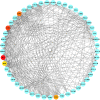Bioinformatics and systems biology approach to identify the pathogenetic link of Long COVID and Myalgic Encephalomyelitis/Chronic Fatigue Syndrome
- PMID: 36189286
- PMCID: PMC9524193
- DOI: 10.3389/fimmu.2022.952987
Bioinformatics and systems biology approach to identify the pathogenetic link of Long COVID and Myalgic Encephalomyelitis/Chronic Fatigue Syndrome
Abstract
Background: The COVID-19 pandemic, caused by severe acute respiratory syndrome coronavirus 2 (SARS-CoV-2), is a global crisis. Although many people recover from COVID-19 infection, they are likely to develop persistent symptoms similar to those of myalgic encephalomyelitis/chronic fatigue syndrome (ME/CFS) after discharge. Those constellations of symptoms persist for months after infection, called Long COVID, which may lead to considerable financial burden and healthcare challenges. However, the mechanisms underlying Long COVID and ME/CFS remain unclear.
Methods: We collected the genes associated with Long COVID and ME/CFS in databases by restricted screening conditions and clinical sample datasets with limited filters. The common genes for Long COVID and ME/CFS were finally obtained by taking the intersection. We performed several advanced bioinformatics analyses based on common genes, including gene ontology and pathway enrichment analyses, protein-protein interaction (PPI) analysis, transcription factor (TF)-gene interaction network analysis, transcription factor-miRNA co-regulatory network analysis, and candidate drug analysis prediction.
Results: We found nine common genes between Long COVID and ME/CFS and gained a piece of detailed information on their biological functions and signaling pathways through enrichment analysis. Five hub proteins (IL-6, IL-1B, CD8A, TP53, and CXCL8) were collected by the PPI network. The TF-gene and TF-miRNA coregulatory networks were demonstrated by NetworkAnalyst. In the end, 10 potential chemical compounds were predicted.
Conclusion: This study revealed common gene interaction networks of Long COVID and ME/CFS and predicted potential therapeutic drugs for clinical practice. Our findings help to identify the potential biological mechanism between Long COVID and ME/CFS. However, more laboratory and multicenter evidence is required to explore greater mechanistic insight before clinical application in the future.
Keywords: Long COVID; ME/CFS; bioinformatics analyses; myalgic encephalomyelitis/chronic fatigue syndrome; protein–protein interaction network; systems biology.
Copyright © 2022 Lv, Zhang, Cai, Huang, Zhan and Liu.
Conflict of interest statement
The authors declare that the research was conducted in the absence of any commercial or financial relationships that could be construed as a potential conflict of interest.
Figures








Similar articles
-
Genetic risk factors for severe and fatigue dominant long COVID and commonalities with ME/CFS identified by combinatorial analysis.J Transl Med. 2023 Nov 1;21(1):775. doi: 10.1186/s12967-023-04588-4. J Transl Med. 2023. PMID: 37915075 Free PMC article.
-
Incidence and Prevalence of Post-COVID-19 Myalgic Encephalomyelitis: A Report from the Observational RECOVER-Adult Study.J Gen Intern Med. 2025 Apr;40(5):1085-1094. doi: 10.1007/s11606-024-09290-9. Epub 2025 Jan 13. J Gen Intern Med. 2025. PMID: 39804551 Free PMC article.
-
Association of SARS-CoV-2 Seropositivity With Myalgic Encephalomyelitis and/or Chronic Fatigue Syndrome Among Children and Adolescents in Germany.JAMA Netw Open. 2022 Sep 1;5(9):e2233454. doi: 10.1001/jamanetworkopen.2022.33454. JAMA Netw Open. 2022. PMID: 36166227 Free PMC article.
-
The persistence of myalgic encephalomyelitis/chronic fatigue syndrome (ME/CFS) after SARS-CoV-2 infection: A systematic review and meta-analysis.J Infect. 2024 Dec;89(6):106297. doi: 10.1016/j.jinf.2024.106297. Epub 2024 Sep 29. J Infect. 2024. PMID: 39353473
-
A scoping review of 'Pacing' for management of Myalgic Encephalomyelitis/Chronic Fatigue Syndrome (ME/CFS): lessons learned for the long COVID pandemic.J Transl Med. 2023 Oct 14;21(1):720. doi: 10.1186/s12967-023-04587-5. J Transl Med. 2023. PMID: 37838675 Free PMC article.
Cited by
-
Non-coding RNAs expression in SARS-CoV-2 infection: pathogenesis, clinical significance, and therapeutic targets.Signal Transduct Target Ther. 2023 Dec 6;8(1):441. doi: 10.1038/s41392-023-01669-0. Signal Transduct Target Ther. 2023. PMID: 38057315 Free PMC article. Review.
-
Cognitive Impairments in Two Samples of Individuals with ME/CFS and Long COVID: A Comparative Analysis.J Clin Psychol Med Settings. 2025 Sep;32(3):507-516. doi: 10.1007/s10880-025-10074-4. Epub 2025 Mar 22. J Clin Psychol Med Settings. 2025. PMID: 40120036
-
Transcriptomic analysis reveals shared gene signatures and molecular mechanisms between obesity and periodontitis.Front Immunol. 2023 Mar 29;14:1101854. doi: 10.3389/fimmu.2023.1101854. eCollection 2023. Front Immunol. 2023. PMID: 37063877 Free PMC article.
-
Knowledge Representation and Management in the Age of Long Covid and Large Language Models: a 2022-2023 Survey.Yearb Med Inform. 2024 Aug;33(1):216-222. doi: 10.1055/s-0044-1800747. Epub 2025 Apr 8. Yearb Med Inform. 2024. PMID: 40199308 Free PMC article. Review.
-
Exploring the Pathophysiology of Long COVID: The Central Role of Low-Grade Inflammation and Multisystem Involvement.Int J Mol Sci. 2024 Jun 9;25(12):6389. doi: 10.3390/ijms25126389. Int J Mol Sci. 2024. PMID: 38928096 Free PMC article. Review.
References
-
- Organization WH . Who coronavirus (Covid-19) dashboard (2022). Available at: https://covid19.who.int/.
-
- Whitaker M, Elliott J, Chadeau-Hyam M, Riley S, Darzi A, Cooke G, et al. . Persistent symptoms following sars-Cov-2 infection in a random community sample of 508,707 people. medRxiv (2021) 13(1):1957. doi: 10.1101/2021.06.28.21259452 - DOI
Publication types
MeSH terms
Substances
LinkOut - more resources
Full Text Sources
Medical
Research Materials
Miscellaneous

